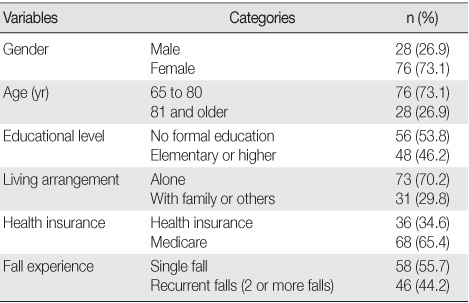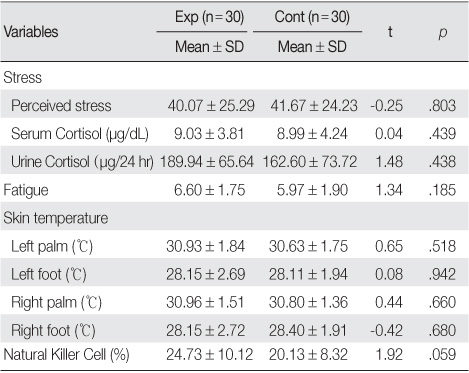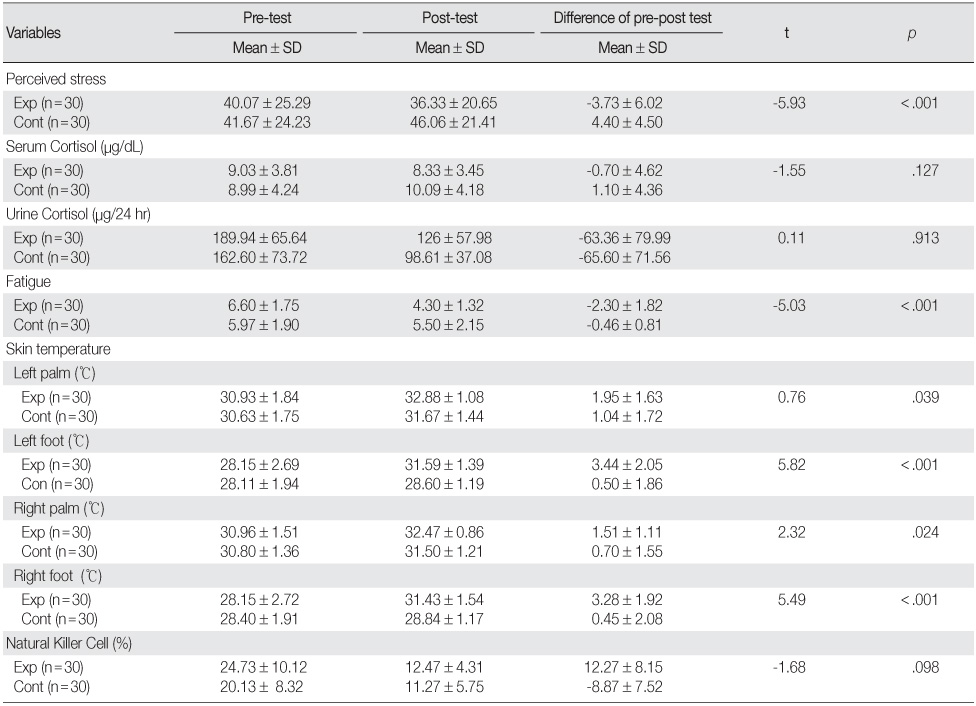Articles
- Page Path
- HOME > J Korean Acad Nurs > Volume 41(1); 2011 > Article
-
Original Article
- Effects of Self-Foot Reflexology on Stress, Fatigue, Skin Temperature and Immune Response in Female Undergraduate Students
- Young-Mee Lee
-
Journal of Korean Academy of Nursing 2011;41(1):110-118.
DOI: https://doi.org/10.4040/jkan.2011.41.1.110
Published online: February 28, 2011
Assistant Professor, Department of Nursing, Kangwon National University, Samcheok 2nd Campus, Samcheok, Korea.
- Address reprint requests to: Lee, Young-Mee. Department of Nursing, Kangwon National University Samcheok 2nd Campus, 3 Hwangjo-ri, Dogye-eup, Samcheok 245-907, Korea. Tel: +82-33-540-3361, Fax: +82-33-540-3369, ymlee@kangwon.ac.kr
© 2011 Korean Society of Nursing Science
Abstract
-
Purpose
- The purpose of this study was to evaluate the effects of self-foot reflexology on stress (perceived stress, urine cortisol level, and serum cortisol level), fatigue, skin temperature and immune response in female undergraduate students.
-
Methods
- The research design was a nonequivalent control group pretest-post test design. Participants were 60 university students: 30 in the experiment group and 30 in the control group. The period of this study was from April to June 2010. The program was performed for 1 hr a session, three times a week for 6 weeks. The data were analyzed using the SPSS/WIN 17.0 program.
-
Results
- The results showed that self-foot reflexology was effective in reducing perceived stress and fatigue, and raised skin temperature in female undergraduate students. But cortisol levels and immune response were not statistically significant different.
-
Conclusion
- The results of this study indicate that self-foot reflexology is an effective nursing intervention in reducing perceived stress and fatigue and, in improving skin temperature. Therefore, it is recommended that this be used in clinical practice as an effective nursing intervention for in female undergraduate students.
- 1. Cameron L, Leventhal EA, Leventhal H. Seeking medical care in response to symptoms and life stress. Psychosomatic Medicine. 1995;57:37–47.ArticlePubMed
- 2. Chon YJ, Kim SJ. Study on the stress and coping method of the university students at the Inha University. Journal of Student Guidance. 1999;1:37–49.
- 3. Cline ME, Herman J, Shaw E, Morter RD. Standardization of visual analogue scale. Nursing Research. 1992;41:378–380.PubMed
- 4. Crane B. Reflexology. The definitive practitioner's manual. 1997;Shaftesbury, Dorset, Element Books.
- 5. Field T, Grizzle N, Scafidi F, Schanberg S. Massage and relaxation therapies effects on depressed adolescent mothers. Touch Research Institute, University of Miami School of Medicine, Florida 33101, USA. Adolescence. 1996;31:903–911.PubMed
- 6. Guyton AC, Hall JE. Text book of medical physiology. 2002;10th ed. Singapore, W.B. Saunders.
- 7. Janeway CA, Travers P, Walport M, Shlomchik MJ. Immunebiology. 2002;5th ed. Seoul, Lifescience.
- 8. Jang SH, Kim KH. Effects of self-foot reflexology on stress, fatigue and blood circulation in premenopausal middle-aged women. Journal of Korean Academy of Nursing. 2009;39:662–672.ArticlePubMed
- 9. Jeong IS. Effect of self-foot reflexology on peripheral blood circulation and peripheral neuropathy in patients with diabetes mellitus. Journal of Korean Academy of Fundamentals Nursing. 2006;13:225–234.
- 10. Kang DH. Physiology. 1992;4th ed. Seoul, ShinKwang Publishing Co.
- 11. Kiecolt-Glaser JK, Cacioppo JT, Malarkey WB, Glaser R. Acute psychologic stressors and short-term immune changes: What, why, for whom, and to what extent (editorial). Psychosomatic Medicine. 1992;54:680–685.ArticlePubMed
- 12. Koh KB, Park JK, Kim CH. Development of the stress response inventory. Journal of Korean Neuropsychiatric Association. 2000;39:707–719.
- 13. Lasarus RS, Folkman S. Stress, appraisal, and coping. 1984;NY, Springer Publishing Co.
- 14. Lee EH. Life stress and depressive symptoms among college students: Testing for moderating effects of coping style university students with structural equations. Korean Journal of Health Psychology. 2004;9:25–52.
- 15. Lee JR. Effects of aromatherapy and foot reflex massage on stress, depression, and sleep pattern of the institutionalized elderly. 2005;Daegu, Kyungpook National University. Unpublished Doctoral Dissertation.
- 16. Lee SH. Effects of back massage with lavender essence oil on the stress response of the ICU nurses. Journal of Korean Academy of Nursing. 2001;31:770–780.ArticlePDF
- 17. Lee YM. Effects of self-foot reflexology massage on depression, stress responses and immune functions of middle aged women. Journal of Korean Academy of Nursing. 2006;36:179–188.PubMed
- 18. Mackey BT. Massage therapy and reflexology awareness. The Nursing Clinics of North America. 2001;36:159–170.ArticlePubMed
- 19. Norman L, Cowan T. The reflexology handbook-A complete guide. 1989;London, Piatkus.
- 20. Oh JS. Self-massage on hands and feets. 1997;Seoul, Sam Sa Dang.
- 21. Oleson T, Flocco W. Randomized controlled study of premenstrual symptoms treated with ear, hand, and foot reflexology. Obstetrics and Gynecology. 1993;82:906–911.ArticlePubMed
- 22. Pawlow LA, Jones GE. The impact of abbreviated progressive muscle relaxation on salivary cortisol. Biological Psychology. 2002;60:1–6.ArticlePubMed
- 23. Piper BF, Lindsey A, Dodd M. Fatigue mechanism on cancerpatients: Developing nursing theory. Oncology Nursing Forum. 1987;14:17–23.
- 24. Powell LH, Lovallo WR, Matthews KA, Meyer P, Midgley AR, Baum A, et al. Physiologic markers of chronic stress in premenopausal middle-aged women. Psychosomatic Medicine. 2002;64:502–509.ArticlePubMed
- 25. Stevens RC, Soelberg SD, Near S, Fuelong CE. Detection of cortisol in saliva with a flow-filtered, portable surface plasmon resonance biosensor system. Analytical Chemistry. 2008;80:6747–6751.ArticlePubMedPMC
- 26. Varricchio CG. Selecting a tool for measuring fatigue. Oncology Nursing Forum. 1985;12:122–127.PubMed
- 27. Wichianson JR, Bughi SA, Unger JB, Spruijt-Metz D, Nguyen-Rodriguez ST. Perceived stress, coping and night-eating in college students. Stress and Health. 2009;25:235–240.Article
REFERENCES
Figure & Data
REFERENCES
Citations

- Systematic review and meta-analysis of reflexology for people with multiple sclerosis: Systematic Review and Meta-Analysis
Xiaohong Ma, Zhaoyu Yuan, Baicheng Qian, Yunxiang Guan, Baoliang Wang
Medicine.2023; 102(5): e32661. CrossRef - The Effect of Limb Massage on Arterial Blood Oxygen Saturation and Body Temperature Changes in Patients Undergoing Surgery
Ali Miri, Mostafa Roshanzadeh, Reza Masoudi, Soleiman Kheiri, Ali Taj, Shirmohammad Davoodvand
Journal of Archives in Military Medicine.2023;[Epub] CrossRef - The Effect of Self-Acupressure on Peripheral Neuropathy, Disturbance in Daily Activity, and Quality of Life in Breast Cancer Patients undergoing Chemotherapy
Su Young Kim, Jeong Sook Park
Asian Oncology Nursing.2021; 21(3): 129. CrossRef - A Study of the Effects of Swedish Massage in a Multisensory Environment on the Health of Women in their 40s and 50s
Seongeun Oh
Asian Journal of Beauty and Cosmetology.2021; 19(3): 365. CrossRef - Effect of foot reflexology on chest pain and anxiety in patients with acute myocardial infarction: A double blind randomized clinical trial
Saeedeh Sayari, Monir Nobahar, Raheb Ghorbani
Complementary Therapies in Clinical Practice.2021; 42: 101296. CrossRef - The Effect of Foot Reflexology Applied Before Coronary Angiography and Percutaneous Transluminal Coronary Angioplasty on Anxiety, Stress, and Cortisol Levels of Individuals
Birgül Vural Doğru, Fisun ŞenuzunAykar, Yasemin Yıldırım, Oğuz Yavuzgil, Eser Sözmen, Hikmet Memmedov
Journal of Cardiovascular Nursing.2021; 36(5): 461. CrossRef - Abdominal Stiffness Evaluation in Massage for Constipation
Yunyi Wang, Chiaki Sakakibara, Miho Shogenji, Mikako Yoshida, Tetsuyou Watanabe
Sensors.2021; 21(4): 1192. CrossRef - Effects of aroma self-foot reflexology on peripheral neuropathy, peripheral skin temperature, anxiety, and depression in gynaecologic cancer patients undergoing chemotherapy: A randomised controlled trial
Gie Ok Noh, Kyung Sook Park
European Journal of Oncology Nursing.2019; 42: 82. CrossRef - Reflexology and polysomnography: Changes in cerebral wave activity induced by reflexology promote N1 and N2 sleep stages
N. Esmel-Esmel, E. Tomás-Esmel, M. Tous-Andreu, A. Bové-Ribé, M. Jiménez-Herrera
Complementary Therapies in Clinical Practice.2017; 28: 54. CrossRef - Effects of Foot-Reflexology Massage on Fatigue, Stress and Postpartum Depression in Postpartum Women
Mi Son Choi, Eun Ja Lee
Journal of Korean Academy of Nursing.2015; 45(4): 587. CrossRef - Effect of self-administered foot reflexology for symptom management in healthy persons: A systematic review and meta-analysis
Hyun Jin Song, Heejeong Son, Hyun-Ju Seo, Heeyoung Lee, Sun Mi Choi, Sanghun Lee
Complementary Therapies in Medicine.2015; 23(1): 79. CrossRef - Effects of the Aroma Inhalation Method with a Roll-on on Life Stress, Salivary Cortisol and Fatigue in Nursing Student
In-Sook Kim, Seung-Ju Kang, Ja-Ok Kim
Journal of the Korea Academia-Industrial cooperation Society.2014; 15(12): 7214. CrossRef - Optical, Spectroscopic, and Doppler Evaluation of “Normal” and “Abnormal” Reflexology Areas in Lumbar Vertebral Pathology: A Case Study
Krishna Dalal, D. Elanchezhiyan, V. B. Maran, Raunak Kumar Das, Piyush Kumar, S. P. Singh, C. Murali Krishna, Jyotirmoy Chatterjee
Case Reports in Medicine.2012; 2012: 1. CrossRef - Effects of Aroma Self-Foot Reflexology Massage on Stress and Immune Responses and Fatigue in Middle-Aged Women in Rural Areas
Ja Ok Kim, In Sook Kim
Journal of Korean Academy of Nursing.2012; 42(5): 709. CrossRef - The Effects of Foot Reflexology on Sleep, Depression and Skin Temperature of the Female Elderly at Home
Chung Soon Kim, Se Hwa Hong, Se Ryeong Kim, Yeo Jin Kim
Journal of Korean Academy of Community Health Nursing.2011; 22(4): 409. CrossRef
Homogeneity Test of General Characteristics (N=60)
*Fisher's test:
Exp=experimental group; Cont=control group.
Homogeneity Test of Pre-test Dependent Variables (N=60)
Exp=experimental group; Cont=control group.
Changes in Stress, Fatigue, Skin temperature, Natural Killer Cell Before and After Self-Foot Reflexology (N=60)
Exp=experimental group; Cont=control group; SBP=Systolic Blood Pressure (mmHg); DBP=Diastolic Blood Pressure (mmHg).
*Fisher's test: Exp=experimental group; Cont=control group.
Exp=experimental group; Cont=control group.
Exp=experimental group; Cont=control group; SBP=Systolic Blood Pressure (mmHg); DBP=Diastolic Blood Pressure (mmHg).
 KSNS
KSNS
 E-SUBMISSION
E-SUBMISSION



 Cite
Cite

